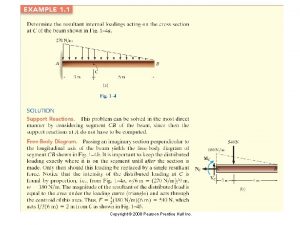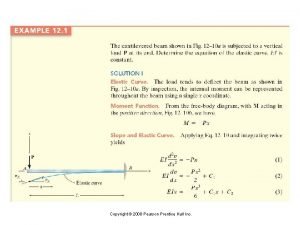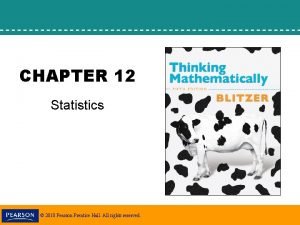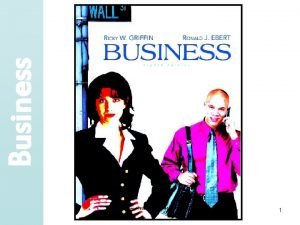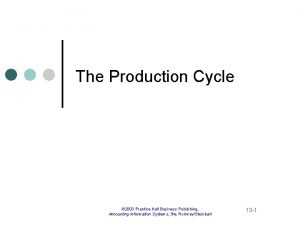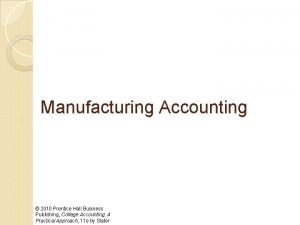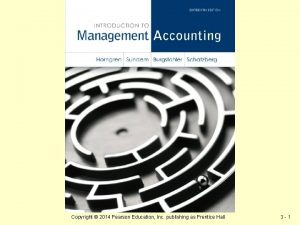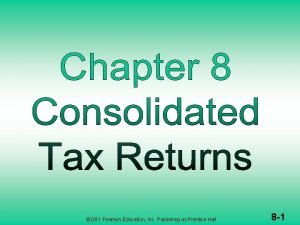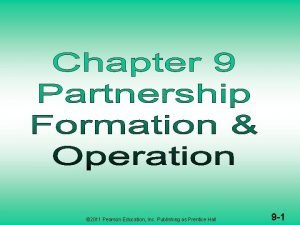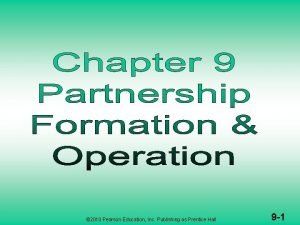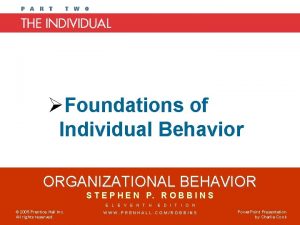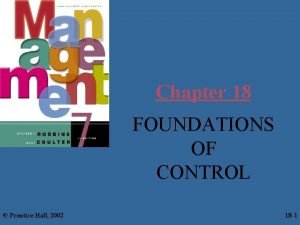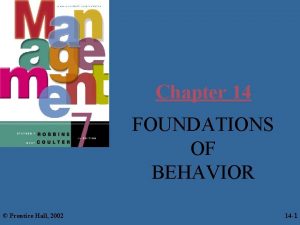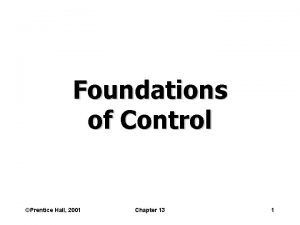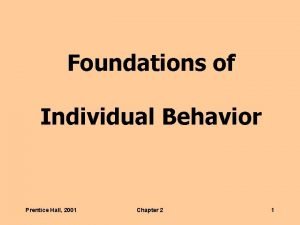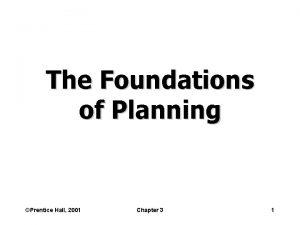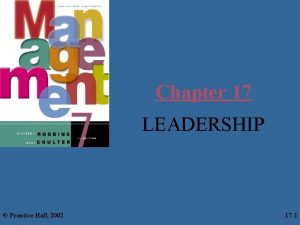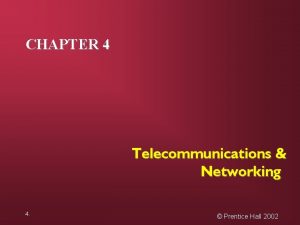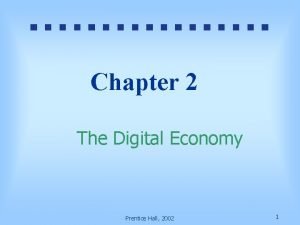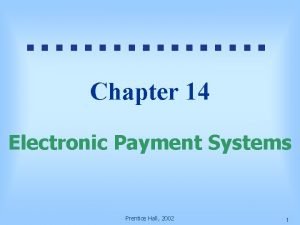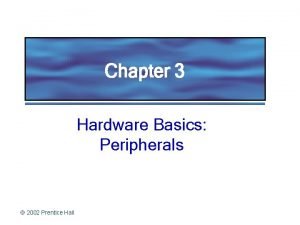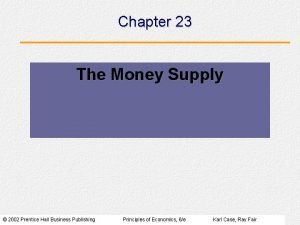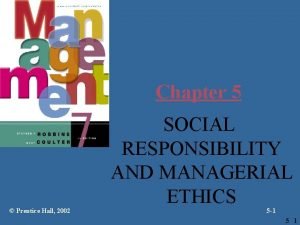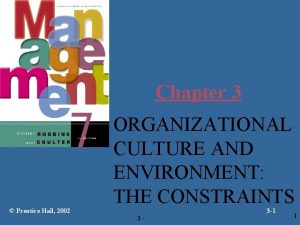Chapter 18 FOUNDATIONS OF CONTROL Prentice Hall 2002































- Slides: 31

Chapter 18 FOUNDATIONS OF CONTROL © Prentice Hall, 2002 18 -11

Learning Objectives You should learn to: – Define control – Describe three approaches to control – Explain why control is important – Describe the control process – Distinguish among the three types of control – Describe the qualities of an effective control system © Prentice Hall, 2002 18 -22

Learning Objectives (cont. ) You should learn to: – Discuss the contingency factors that influence the design of an organization’s control system – Identify how controls need to be adjusted for cultural differences – Explain how three contemporary issues workplace privacy, employee theft, and workplace violence - affect control © Prentice Hall, 2002 18 -33

What Is Control? Control – the process of monitoring activities to ensure that they are being accomplished as planned and of correcting significant deviations – control systems are judged in terms of how well they facilitate goal achievement – market control - emphasizes the use of external market mechanisms to establish standards of performance • useful where products and services are distinct • useful where marketplace competition is considerable • divisions turned into profit centers and judged by the percentage of total corporate profits each contributes © Prentice Hall, 2002 18 -44

What Is Control? (cont. ) Control – bureaucratic control - emphasizes organizational authority • relies on administrative rules, procedures, and policies • depends on standardization of activities, well-defined job descriptions, and other administrative mechanisms – clan control - behavior regulated by shared values, traditions, and other aspects of organizational culture • dependent on individual and group to identify expected behaviors and performance measures • found where teams are common and technology changes often © Prentice Hall, 2002 18 -55

Why Is Control Important? Control is the Final Link in the Management Process – provides the critical link back to planning – only way managers know whether organizational goals are being met Permits Delegation of Authority – fear that employees will do something wrong for which the manager will be held responsible – provides information and feedback on employee performance © Prentice Hall, 2002 18 -66

The Planning-Controlling Link Planning Goals Objectives Strategies Plans Controlling Standards Measurements Comparisons Actions © Prentice Hall, 2002 Organizing Structure Human Resource Management Leading Motivation Leadership Communication Individual and Group Behavior 18 -77

The Control Process © Prentice Hall, 2002 18 -88

The Control Process Background – controlling is a three-step process – assumes that performance standards already exist • specific goals are created in the planning process Measuring – How We Measure • personal observation - permits intensive coverage – Management By Walking Around (MBWA) – drawbacks - subject to personal biases » consumes a great deal of time » suffers from obtrusiveness © Prentice Hall, 2002 18 -99

The Control Process (cont. ) Measuring (cont. ) – How We Measure (cont. ) • statistical reports - numerical data are easy to visualize and effective for showing relationships – drawbacks - not all operations can be measured » important subjective factors may be ignored • oral reports - includes meetings, telephone calls – may be best way to control work in a virtual environment – technology permits creation of written record from oral report – drawbacks - filtering of information © Prentice Hall, 2002 18 -10 10

The Control Process (cont. ) How We Measure (cont. ) – written reports - often more comprehensive and concise than oral reports • usually easy to file and retrieve – comprehensive control efforts should use all four approaches © Prentice Hall, 2002 18 -11 11

The Control Process (cont. ) What We Measure – what we measure more critical than how we measure – control criteria applicable to any management situation: • employee satisfaction, absenteeism, and turnover • keeping costs within budgets – control system needs to recognize the diversity of activities – some activities difficult to measure in quantifiable terms • most activities can be grouped into some objective segments that can be measured • when objective measures are not available, should rely on subjective measures © Prentice Hall, 2002 18 -12 12

The Control Process (cont. ) Comparing – determines the degree of variation between actual performance and standard – acceptable range of variation - deviations that exceed this range become significant © Prentice Hall, 2002 18 -13 13

Measurement of Performance Defining The Acceptable Range Of Variation Acceptable Upper Limit Acceptable Range of Variation Standard Acceptable Lower Limit t © Prentice Hall, 2002 t+1 t+2 t+3 t+4 Time Period (t) t+5 18 -14 14

Sales Performance Figures For July, Eastern States Distributors Brand Heineken Molson Irish Amber Victoria Bitter Labatt’s Corona Amstel Light Dos Equis Tecate Total cases Standard* 1, 075 630 800 620 540 160 225 80 170 4, 300 Actual* 913 634 912 622 672 140 220 65 286 4, 464 Over (under)* (162) 4 112 2 132 (20) (5) (15) 116 164 * hundreds of cases © Prentice Hall, 2002 18 -15 15

The Control Process (cont. ) Taking Managerial Action – Correct Actual Performance - action taken when the performance variation is unsatisfactory • immediate corrective action - corrects problems at once to get performance back on track • basic corrective action - identifies reason for performance variation – corrects the source of variation – Revise the Standard - variance results from an unrealistic standard • standard, not performance, needs correction • troublesome to revise the standard downward © Prentice Hall, 2002 18 -16 16

Managerial Decisions in the Control Process © Prentice Hall, 2002 18 -17 17

Types Of Control Feedforward Control – prevents anticipated problems – most desirable type of control – requires timely and accurate information that often is difficult to get Concurrent Control – takes place while activity is in progress – corrects problem before it becomes too costly – best-known form is direct supervision © Prentice Hall, 2002 18 -18 18

Types of Control (cont. ) Feedback Control – takes place after the activity is done – problems may already have caused damage or waste – the most popular type of control • feedback may be only viable form of control available – feedback has two advantages • provides meaningful information on the effectiveness of planning • can enhance employee motivation © Prentice Hall, 2002 18 -19 19

Types Of Control Input Processes Output Feedforward Control Concurrent Control Feedback Control Anticipates problems Corrects problems as they happen Corrects problems after they occur © Prentice Hall, 2002 18 -20 20

Qualities Of An Effective Control System Corrective Action Accuracy Multiple Criteria Emphasis on Exceptions Timeliness EFFECTIVE CONTROL SYSTEM Strategic Placement Flexibility Reasonable Criteria © Prentice Hall, 2002 Economy Understandability 18 -21 21

Contingency Factors in the Design of Control Systems © Prentice Hall, 2002 18 -22 22

Implications For Managers Adjusting Controls for Cultural Differences – methods of controlling people and work can be quite different in other countries • differences are most marked in the measurement and corrective action steps – in technologically advanced nations, controls are indirect – in less technologically advanced nations, controls are more direct – laws in different countries provide different constraints on corrective action – data used for controlling may not be comparable in different countries © Prentice Hall, 2002 18 -23 23

Contemporary Issues In Control Workplace Privacy – employers have the right to monitor employee communications, examine employee computers and files, and use surveillance cameras – reasons for monitoring include prevention of: • recreational on-the-job Web surfing • creation of hostile work environments with e-mail • security leaks of critical information – Electronic Communications Privacy Act - 1986 • prohibits unauthorized interception of electronic communication • workplace electronic monitoring is still legal © Prentice Hall, 2002 18 -24 24

Contemporary Issues In Control (cont. ) Workplace Privacy (cont. ) – companies are developing and enforcing workplace monitoring policies • develop unambiguous computer usage policy • inform employees that computers may be monitored • provide clear guidelines on acceptable use of company e-mail system and the Web © Prentice Hall, 2002 18 -25 25

Workplace Monitoring Track telephone calls (numbers and time spent) Store and review employee e-mail messages Store and review computer files Log computer time and keystrokes entered Record and review telephone conversations Store and review voice-mail messages © Prentice Hall, 2002 39% 27% 21% 15% 11% 6% 18 -26 26

Contemporary Issues In Control (cont. ) Employee Theft – unauthorized taking of company property by employees for their personal use – is an escalating problem in all types of organizations – different proposals to explain employee theft • industrial security - opportunity presents itself due to lack of controls and favorable circumstances • criminology - people have financial-based pressures or vice-based pressures • clinical psychology - people are able to rationalize any type of behavior © Prentice Hall, 2002 18 -27 27

Control Measure for Deterring or Reducing Employee Theft or Fraud © Prentice Hall, 2002 18 -28 28

Contemporary Issues In Control (cont. ) Workplace Violence – many factors contribute to workplace violence including: • employee work driven by time, numbers, and crises • rapid and unpredictable change • destructive communication style of manager • authoritarian leadership • defensive attitude • double standards • unresolved grievances • emotionally troubled employees • repetitive, boring work © Prentice Hall, 2002 18 -29 29

Contemporary Issues In Control (cont. ) Workplace Violence (cont. ) – contributing factors (cont. ) • faulty or unsafe equipment • hazardous work environment • culture of violence © Prentice Hall, 2002 18 -30 30

Workplace Violence Witnessed yelling and other verbal abuse Yelled at coworkers themselves Cried over work-related issues Seen someone purposely damage machines or furniture Seen physical violence in the workplace Struck a coworker © Prentice Hall, 2002 42% 29% 23% 14% 10% 2% 18 -31 31
 Copyright 2008
Copyright 2008 Prentice hall inc
Prentice hall inc 2008 pearson prentice hall inc
2008 pearson prentice hall inc 2005 pearson prentice hall inc
2005 pearson prentice hall inc Pearson prentice hall
Pearson prentice hall Prentice hall inc
Prentice hall inc Prentice hall careers
Prentice hall careers Prentice hall america pathways to the present
Prentice hall america pathways to the present Pearson education 2011
Pearson education 2011 Prentice hall business publishing
Prentice hall business publishing Prentice hall african american history
Prentice hall african american history Prentice hall physical science concepts in action
Prentice hall physical science concepts in action Pearson education inc publishing as pearson prentice hall
Pearson education inc publishing as pearson prentice hall Pearson prentice hall
Pearson prentice hall Pearson prentice hall
Pearson prentice hall 2005 pearson prentice hall inc
2005 pearson prentice hall inc Pearson education inc publishing as pearson prentice hall
Pearson education inc publishing as pearson prentice hall Arthropods common name
Arthropods common name Prentice hall business publishing
Prentice hall business publishing Pearson education inc. publishing as prentice hall
Pearson education inc. publishing as prentice hall Pearson education inc. publishing as prentice hall
Pearson education inc. publishing as prentice hall Pearson education inc. 2012
Pearson education inc. 2012 Prentice hall jobs
Prentice hall jobs Pearson education inc. publishing as prentice hall
Pearson education inc. publishing as prentice hall Pearson education inc. publishing as prentice hall
Pearson education inc. publishing as prentice hall 2010 pearson education inc
2010 pearson education inc Pearson education inc. publishing as prentice hall
Pearson education inc. publishing as prentice hall Foundations of a healthy relationship
Foundations of a healthy relationship Chapter 6 lesson 1 foundations of a healthy relationship
Chapter 6 lesson 1 foundations of a healthy relationship Describe the care team and the chain of command
Describe the care team and the chain of command Chapter 2 foundations of individual behavior
Chapter 2 foundations of individual behavior Guided reading activity foundations of government lesson 1
Guided reading activity foundations of government lesson 1

